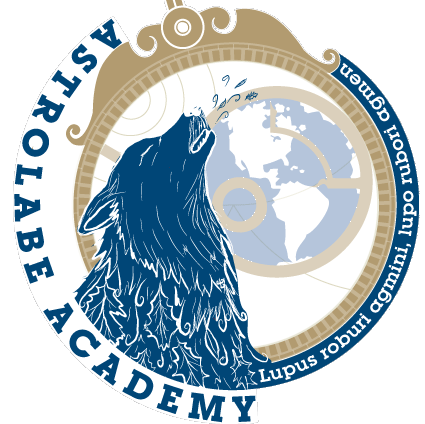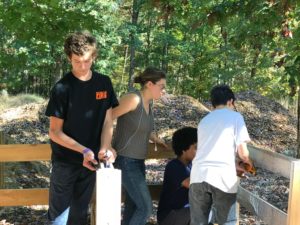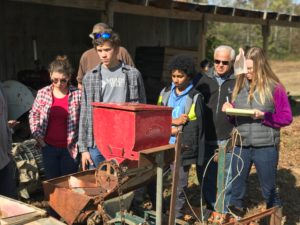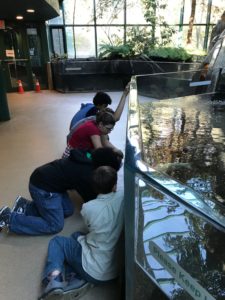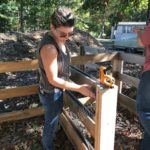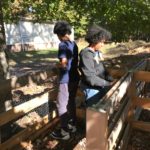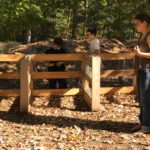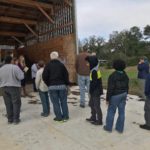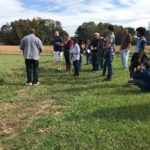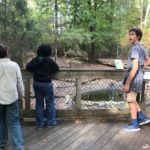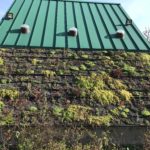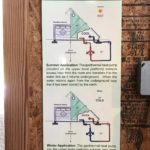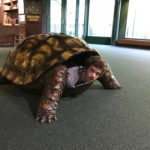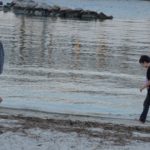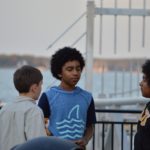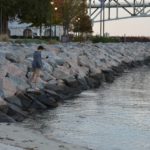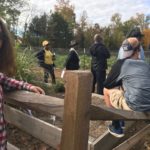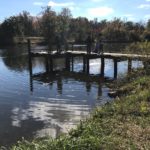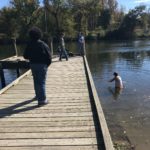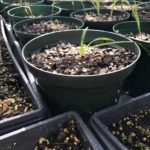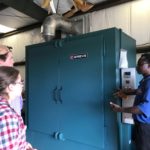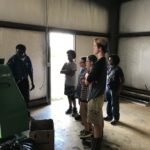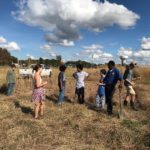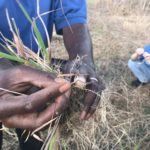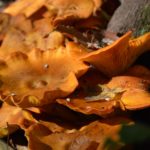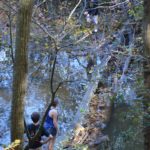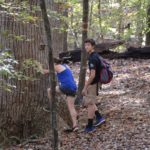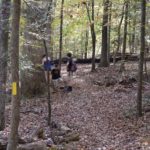Week of October 30, 2017
This has been our busiest off-farm activity so far! This week, the students continued to study TED talks and explore the science and agriculture of coastal plains. But they spent far more time outside working on projects, attending VSU educational farm events and exploring some of the local resources!
Monday we began by welcoming both a full-time and part-time student through exercises that pushed both creativity in problem solving as well as collaboration. Students spent the morning stretching their ability to think a bit more outside the box. After lunch, we headed outside for some raking and general yard cleanup.
On Tuesday, we followed up our morning academic time by finishing up the compost bins. A potential new student joined us as we added chicken wire to the bins and got one complete project under out belt!
The remainder of the week we spent off-site. Wednesday, we welcomed a new student and headed to Surry, VA to visit Slade’s Farm for a VSU workshop on nutrient management. Students heard Mr. Slade talk about the issues he had with unprotected nutrient losses through runoff as well as its impact on the waterways. He showed us his new pole barn designed with huge bins to hold compost and other soil amendments, keeping them clean, dry, easily accessible and out of the creeks and streams that lace his farm property. He talked about the resources available to help with these issues, things he’s learned to grow his crops more productively and some machinery he uses for this work.
After the tour, we headed to Newport News, had lunch at a great Mexican restaurant, José Tequilas, and then made our way to the Virginia Living Museum around the corner. Here, we saw some of the native species that reside in Virginia, including deer, bald eagles, vultures, bobcat, and the very rare red wolf to name a few. The animals housed at the museum are sick or injured animals being rehabilitated or permanently housed depending on their ability to return to the wild. The museum has two large exhibits on either end of the building that show plants and animals typical to the main geological areas of the state–the piedmont/mountain region and the coastal region. It served as a nice wrap up to our science studies of these areas, especially as we focused on the coastal region in which the school is located. The museum also features an ecologically friendly human habitat, showcasing some of the ways we can reduce our energy consumption. It also hosts a lego sculpture exhibition and a large lego block building area which is as popular with teens as it is the youngsters.
We couldn’t come this close to all of the waterways of the Newport News peninsula without stopping for just a bit. We found Water Street in York Town to be a great spot. The students wandered, explored, and talked about the historical significance of this area. We wrapped up this amazing day with Ben & Jerry’s Ice Cream and watched the moon rise over the water as we walked back to our vehicle.
By Thursday, we had already done a month’s worth of field trips and explorations, but we had more plans! Thursday morning started with a VSU urban garden tour. VSU’s Dr. Githinji and other speakers talked about the Growing Petersburg Garden Project and winter crops before leading us on a short tour of the garden. Afterward we found Rosslyn Park, a local Appomattox River access point and termination of the the Appomattox River Trail for a picnic lunch and exploration. This will make a great place to begin or end some kayaking adventures in the future! Following lunch, we met Dr. Temu, Associate Professor, VSU’s Small Ruminant Program, for a private tour of this ruminant forage research. Dr. Temu is experimenting with reviving native grasses that had almost become extinct due to excessive overgrazing and tilling practices for feeding ruminants. His tour started in the greenhouse and ended with the machinery used to harvest, dry and separate the seeds for the grasses to continue the growing experiments. Dr. Temu then followed us to our potential long-term home for the school. This 256 acre property had been timbered and left to regrow naturally. It would serve as an interesting experiment for recovering the land through environmentally friendly animal husbandry practices as well as possibly provide an extension to his grass experiments.
Friday was a day to relax and let our minds process all of the incredible information we took in this week! We headed over to Pocahontas State Park for some outdoor recreational time. We enjoyed the rolling terrain, water views and colorful fall foliage. Some of the student had some time to fish while other explored the area around the lake. Thanks to a parent gift, we took Ledo’s Pizza back to the school for a great lunch and finished the day with independent study time.
- LoSU students add chicken wire to the compost bins to complete this project.
- LoSU students add chicken wire to the compost bins to complete this project.
- LoSU students add chicken wire to the compost bins to complete this project.
- VSU tour at Slade’s Farm in Surry, VA to discuss nutrient management on the farm.
- VSU tour at Slade’s Farm in Surry, VA to discuss nutrient management on the farm.
- VSU tour at Slade’s Farm in Surry, VA to discuss nutrient management on the farm.
- Virginia Wildlife Museum visit. Students explored fossils, examples of the geological divisions of VA as well as indigenous wildlife. This was a perfect followup to our studies in the coastal plain and natural resources of VA.
- Virginia Wildlife Museum visit.
- Virginia Wildlife Museum visit had an ecologically friendly human habitat example to explore!
- Virginia Wildlife Museum visit had an ecologically friendly human habitat example to explore!
- Virginia Wildlife Museum visit had an ecologically friendly human habitat example to explore!
- Virginia Wildlife Museum visit. Be a turtle…
- Virginia Wildlife Museum visit. Students hanging out for a moment.
- Virginia Wildlife Museum animals on exhibit are injured and unable to return to the wild.
- Virginia Wildlife Museum visit. Dinosaur exhibits are interactive!!
- Virginia Wildlife Museum visit. Halloween fun!
- Virginia Wildlife Museum visit.
- Virginia Wildlife Museum visit. Lego building area. Even teens love this!
- Virginia Wildlife Museum visit. Lego building area. Even teens love this!
- A side detour to York, VA on the way home.
- A side detour to York, VA on the way home.
- We cannot get this close to the beaches without stopping!
- A side detour to York, VA on the way home.
- A side detour to York, VA on the way home.
- A side detour to York, VA on the way home.
- We ended this big day of exploration with an ice cream treat!
- VSU urban farm tour and discuss about growing in the winter.
- VSU urban farm tour and discuss about growing in the winter.
- Rosslyn Landing Park marks the Appomattox River Trail. We stopped here for a picnic lunch and some exploration in between farm events.
- Rosslyn Landing Park marks the Appomattox River Trail. We stopped here for a picnic lunch and some exploration in between farm events.
- VSU tour of ruminant forage experiments with Dr. Temu. It all starts in the greenhouse.
- VSU tour of ruminant forage experiments with Dr. Temu. Native seedling grasses.
- VSU tour of ruminant forage experiments with Dr. Temu who showed the plant growth as they were nearing the size and age to transplant in the fields.
- VSU tour of ruminant forage experiments with Dr. Temu showing students a small dryer.
- VSU tour of ruminant forage experiments with Dr. Temu showing students a small scale threshing machine perfect for their experiments.
- VSU tour of ruminant forage experiments with Dr. Temu.
- VSU tour of ruminant forage experiments with Dr. Temu.
- VSU tour of ruminant forage experiments with Dr. Temu.
- VSU tour of ruminant forage experiments with Dr. Temu explaining the root and growth systems of these native grasses.
- VSU tour of ruminant forage experiments with Dr. Temu.
- VSU tour of ruminant forage experiments with Dr. Temu showing the students the machine used to collect the grass seeds.
- VSU’s Dr. Temu followed us to our proposed long-term school site to discuss the possibilities of extending his ruminant experiments there.
- Students find newts in puddles at the proposed long-term school property.
- Students enjoy some leisure time hiking a trail in the Pocahontas State Park in Chesterfield.
- Fungi growing in a tree along the trail. Pocahontas State Park in Chesterfield.
- Students enjoy some leisure time hiking a trail in the Pocahontas State Park in Chesterfield.
- Students enjoy some leisure time hiking a trail in the Pocahontas State Park in Chesterfield.
- Students enjoy some leisure time hiking a trail in the Pocahontas State Park in Chesterfield.
- Students enjoy some leisure time hiking a trail in the Pocahontas State Park in Chesterfield.
Featured in:
Richmond Times Dispatch - "When a Farm is Your Classroom"
Goochland Gazette - "Local Farm School Making Move to Charles City"
Cheryl Tan Media Podcast 49: [Strategy] Re-engage Your Tribe
Richmond Magazine – Private School Report 2017
NBC12 – Farm-based high school offers alternative for students
Goochland Gazette - "A new view of school"
Educators Challenged to Increase Interest in Agriculture
[FBW]
